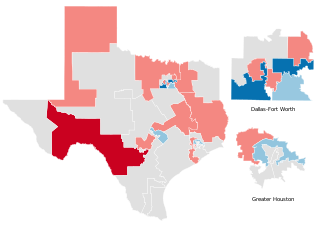
The 2020 United States Senate elections were held on November 3, 2020, with the 33 class 2 seats of the Senate contested in regular elections. Of these, 21 were held by Republicans, and 12 by Democrats. The winners were elected to six-year terms from January 3, 2021, to January 3, 2027. Two special elections for seats held by Republicans were also held in conjunction with the general elections: one in Arizona, to fill the vacancy created by John McCain's death in 2018; and one in Georgia, following Johnny Isakson's resignation in 2019. In both races, the appointed incumbent Republicans lost to Democrats. These elections ran concurrently with the 2020 United States presidential election in which incumbent Republican president Donald Trump lost to Democratic nominee Joe Biden.

The 2018 Texas State Senate elections took place as part of the biennial United States elections. Texas voters elected state senators in 15 of the state senate's 31 districts. State senators serve four-year terms in the Texas State Senate. A statewide map of Texas's state Senate districts can be obtained from the Texas Legislative Council here, and individual district maps can be obtained from the U.S. Census here.

The 2018 Hawaii Senate elections took place as part of the biennial United States elections. Hawaii voters elected state senators in 13 of the state senate's 25 districts. State senators serve four-year terms in the Hawaii Senate.

The 2000 Iowa State Senate elections took place as part of the biennial 2000 United States elections. Iowa voters elected state senators in half of the state senate's districts—the 25 even-numbered state senate districts. State senators serve four-year terms in the Iowa State Senate, with half of the seats up for election each cycle. A statewide map of the 50 state Senate districts in the year 2000 is provided by the Iowa General Assembly here.

The 1998 Iowa State Senate elections took place as part of the biennial 1998 United States elections. Iowa voters elected state senators in half of the state senate's districts—the 25 odd-numbered state senate districts. State senators serve four-year terms in the Iowa State Senate, with half of the seats up for election each cycle. A statewide map of the 50 state Senate districts in the year 1998 is provided by the Iowa General Assembly here.

The 1996 Iowa State Senate elections took place as part of the biennial 1996 United States elections. Iowa voters elected state senators in half of the state senate's districts—the 25 even-numbered state senate districts. State senators serve four-year terms in the Iowa State Senate, with half of the seats up for election each cycle. A statewide map of the 50 state Senate districts in the year 1996 is provided by the Iowa General Assembly here.

The 2020 Iowa State Senate elections took place as part of the biennial 2020 United States state legislative elections. Iowa voters elected state senators in half of the state senate's districts – the 25 even-numbered state senate districts. State senators serve four-year terms in the Iowa Senate, with half of the seats up for election each cycle.

The 1994 Iowa State Senate elections took place as part of the biennial 1994 United States elections. Iowa voters elected state senators in half of the state senate's districts—the 25 odd-numbered state senate districts. State senators serve four-year terms in the Iowa State Senate, with half of the seats up for election each cycle. A statewide map of the 50 state Senate districts in the year 1994 is provided by the Iowa General Assembly here.

The 1992 Iowa State Senate elections took place as part of the biennial 1992 United States elections. Iowa voters elected state senators in 32 of the state senate's 50 districts—all 25 of the even-numbered seats were up for regularly-scheduled elections and, due to the oddities of redistricting following the 1990 Census, seven of the odd-numbered seats were up as well. State senators serve four-year terms in the Iowa State Senate, with half of the seats traditionally up for election each cycle.

The 2020 Texas State Senate elections took place as part of the biennial United States elections. Texas voters elected state senators in 16 of the 31 state senate districts. State senators serve four-year terms in the Texas State Senate. Those elected in 2020 will only be elected for two years, however, as part of the 2-4-4 term system. A statewide map of Texas's state Senate districts can be obtained from the Texas Legislative Council. and individual district maps can be obtained from the U.S. Census.

The 1988 Iowa State Senate elections took place as part of the biennial 1988 United States elections. Iowa voters elected state senators in half of the state senate's districts—the 25 even-numbered state senate districts. State senators serve four-year terms in the Iowa State Senate, with half of the seats up for election each cycle. A statewide map of the 50 state Senate districts in the year 1988 is provided by the Iowa General Assembly here.

The 1986 Iowa State Senate elections took place as part of the biennial 1986 United States elections. Iowa voters elected state senators in half of the state senate's districts—the 25 odd-numbered state senate districts. State senators serve four-year terms in the Iowa State Senate, with half of the seats up for election each cycle. A statewide map of the 50 state Senate districts in the year 1986 is provided by the Iowa General Assembly here.

The 1984 Iowa State Senate elections took place as part of the biennial 1984 United States elections. Iowa voters elected state senators in half of the state senate's districts—the 25 even-numbered state senate districts. State senators serve four-year terms in the Iowa State Senate, with half of the seats up for election each cycle. A statewide map of the 50 state Senate districts in the year 1984 is provided by the Iowa General Assembly here.

The 1980 Iowa State Senate elections took place as part of the biennial 1980 United States elections. Iowa voters elected state senators in half of the state senate's districts—the 25 even-numbered state senate districts. State senators serve four-year terms in the Iowa State Senate, with half of the seats up for election each cycle. A statewide map of the 50 state Senate districts in the year 1980 is provided by the Iowa General Assembly here.

The 1978 Iowa State Senate elections took place as part of the biennial 1978 United States elections. Iowa voters elected state senators in half of the state senate's districts—the 25 odd-numbered state senate districts. State senators serve four-year terms in the Iowa State Senate, with half of the seats up for election each cycle. A statewide map of the 50 state Senate districts in the year 1978 is provided by the Iowa General Assembly here.

The 1974 Iowa State Senate elections took place as part of the biennial 1974 United States elections. Iowa voters elected state senators in 26 of the state senate's districts—the 25 odd-numbered state senate districts and a special election in district 10. State senators serve four-year terms in the Iowa State Senate, with half of the seats up for regularly-scheduled election each cycle. A statewide map of the 50 state Senate districts in the year 1974 is provided by the Iowa General Assembly here.

The 1972 Iowa State Senate elections took place as part of the biennial 1972 United States elections. Iowa voters elected state senators in all of the state senate's 50 districts—the 25 even-numbered seats were up for regularly-scheduled four-year terms and, due to the oddities of redistricting following the 1970 Census, the 25 odd-numbered seats were up for shortened two-year terms. State senators typically serve four-year terms in the Iowa State Senate, with half of the seats traditionally up for election each cycle. The decennial census and redistricting process causes one cycle each decade to be disrupted.

The 2014 Texas State Senate elections took place as part of the biennial United States elections. Texas voters elected state senators in 15 of the 31 state senate districts. State senators serve four-year terms in the Texas State Senate. A statewide map of Texas's state Senate districts can be obtained from the Texas Legislative Council here, and individual district maps can be obtained from the U.S. Census here.

The 2012 Texas State Senate elections took place as part of the biennial United States elections. Texas voters elected state senators in all 31 State Senate districts. Typically, State senators serve four-year terms in the Texas State Senate; however, all Senate seats come up for election in the cycle after decennial redistricting. Due to this, senators elected in 2008 served only two-year terms, and half of the senators elected in this election served two-year terms, coming up for re-election again in 2014. A statewide map of Texas's state Senate districts can be obtained from the Texas Legislative Council here, and individual district maps can be obtained from the U.S. Census here.

The 2010 Texas State Senate elections took place as part of the biennial United States elections. Texas voters elected state senators in 16 State Senate districts. State senators typically serve four-year terms in the Texas State Senate, but all Senators come up for election in the cycles following each decennial redistricting. As such, all of the seats up for this election were for two-year terms, with senators up for re-election in the following 2012 Texas State Senate elections.
















